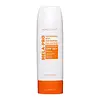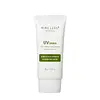What's inside
What's inside
 Key Ingredients
Key Ingredients

 Benefits
Benefits

 Concerns
Concerns

 Ingredients Side-by-side
Ingredients Side-by-side

Water
Skin ConditioningCaprylic/Capric Triglyceride
MaskingGlycereth-26
HumectantEthylhexyl Methoxycinnamate
UV AbsorberEthylhexyl Salicylate
UV AbsorberDimethicone
EmollientBis-Ethylhexyloxyphenol Methoxyphenyl Triazine
Skin ConditioningTitanium Dioxide
Cosmetic ColorantPolysorbate 60
EmulsifyingNiacinamide
SmoothingTranexamic Acid
AstringentGlyceryl Stearate
EmollientPEG-100 Stearate
Dipropylene Glycol
HumectantHydroxyethyl Acrylate/Sodium Acryloyldimethyl Taurate Copolymer
Emulsion StabilisingHydroxyacetophenone
AntioxidantC12-16 Alcohols
EmollientSorbitan Sesquioleate
EmulsifyingCyclopentasiloxane
EmollientAluminum Hydroxide
EmollientCaprylyl Glycol
EmollientSodium Polyacrylate
AbsorbentHydrogenated Lecithin
EmulsifyingEthylhexyl Stearate
EmollientStearic Acid
CleansingPalmitic Acid
EmollientHydrogen Dimethicone
Xanthan Gum
EmulsifyingDimethicone/Vinyl Dimethicone Crosspolymer
Skin ConditioningSorbitan Isostearate
EmulsifyingTrideceth-6
EmulsifyingDisodium EDTA
Dipotassium Glycyrrhizate
HumectantParfum
MaskingWater, Caprylic/Capric Triglyceride, Glycereth-26, Ethylhexyl Methoxycinnamate, Ethylhexyl Salicylate, Dimethicone, Bis-Ethylhexyloxyphenol Methoxyphenyl Triazine, Titanium Dioxide, Polysorbate 60, Niacinamide, Tranexamic Acid, Glyceryl Stearate, PEG-100 Stearate, Dipropylene Glycol, Hydroxyethyl Acrylate/Sodium Acryloyldimethyl Taurate Copolymer, Hydroxyacetophenone, C12-16 Alcohols, Sorbitan Sesquioleate, Cyclopentasiloxane, Aluminum Hydroxide, Caprylyl Glycol, Sodium Polyacrylate, Hydrogenated Lecithin, Ethylhexyl Stearate, Stearic Acid, Palmitic Acid, Hydrogen Dimethicone, Xanthan Gum, Dimethicone/Vinyl Dimethicone Crosspolymer, Sorbitan Isostearate, Trideceth-6, Disodium EDTA, Dipotassium Glycyrrhizate, Parfum
Water
Skin ConditioningAcrylates Copolymer
Butylene Glycol
HumectantEthylhexyl Palmitate
EmollientButyloctyl Salicylate
Skin ConditioningGlycerin
HumectantEthylhexyl Triazone
UV AbsorberDiethylamino Hydroxybenzoyl Hexyl Benzoate
UV Filter1,2-Hexanediol
Skin ConditioningNiacinamide
SmoothingDicaprylyl Carbonate
EmollientC14-22 Alcohols
Emulsion StabilisingCetearyl Olivate
Bis-Ethylhexyloxyphenol Methoxyphenyl Triazine
Skin ConditioningVinyl Dimethicone/Methicone Silsesquioxane Crosspolymer
Sorbitan Olivate
EmulsifyingPoly C10-30 Alkyl Acrylate
Emulsion StabilisingC12-20 Alkyl Glucoside
EmulsifyingMethyl Glucose Sesquistearate
EmollientPolyacrylate Crosspolymer-6
Emulsion StabilisingCetearyl Alcohol
EmollientGlyceryl Stearate Se
EmulsifyingPrunus Amygdalus Amara Kernel Oil
MaskingHedera Helix Leaf/Stem Extract
AntimicrobialAdenosine
Skin ConditioningPyrus Malus Fruit Extract
Skin ConditioningDisodium EDTA
Stearic Acid
CleansingT-Butyl Alcohol
PerfumingVanilla Planifolia Fruit Extract
Skin ConditioningJasminum Officinale Flower Water
MaskingGlucose
HumectantMacadamia Ternifolia Seed Oil
EmollientCaprylic/Capric Triglyceride
MaskingPropanediol
SolventHyaluronic Acid
HumectantTocopherol
AntioxidantBrassica Campestris Sterols
EmollientCholesterol
EmollientPhytosteryl/Behenyl/Octyldodecyl Lauroyl Glutamate
Skin ConditioningPhenoxyethanol
PreservativeCentella Asiatica Extract
CleansingPolyglyceryl-10 Oleate
Skin ConditioningHydrogenated Lecithin
EmulsifyingCeramide NP
Skin ConditioningPotassium Cetyl Phosphate
EmulsifyingBeta-Glucan
Skin ConditioningEthylhexylglycerin
Skin ConditioningMorinda Citrifolia Extract
AstringentCamellia Sinensis Leaf Extract
AntimicrobialHouttuynia Cordata Extract
Skin ConditioningMelaleuca Alternifolia Leaf Extract
PerfumingPetroselinum Sativum Extract
Skin ConditioningMentha Piperita Leaf Extract
Skin ConditioningHippophae Rhamnoides Fruit Extract
Skin ConditioningAureobasidium Pullulans Ferment
Skin ConditioningCeramide Ns
Skin ConditioningCeramide EOP
Skin ConditioningWater, Acrylates Copolymer, Butylene Glycol, Ethylhexyl Palmitate, Butyloctyl Salicylate, Glycerin, Ethylhexyl Triazone, Diethylamino Hydroxybenzoyl Hexyl Benzoate, 1,2-Hexanediol, Niacinamide, Dicaprylyl Carbonate, C14-22 Alcohols, Cetearyl Olivate, Bis-Ethylhexyloxyphenol Methoxyphenyl Triazine, Vinyl Dimethicone/Methicone Silsesquioxane Crosspolymer, Sorbitan Olivate, Poly C10-30 Alkyl Acrylate, C12-20 Alkyl Glucoside, Methyl Glucose Sesquistearate, Polyacrylate Crosspolymer-6, Cetearyl Alcohol, Glyceryl Stearate Se, Prunus Amygdalus Amara Kernel Oil, Hedera Helix Leaf/Stem Extract, Adenosine, Pyrus Malus Fruit Extract, Disodium EDTA, Stearic Acid, T-Butyl Alcohol, Vanilla Planifolia Fruit Extract, Jasminum Officinale Flower Water, Glucose, Macadamia Ternifolia Seed Oil, Caprylic/Capric Triglyceride, Propanediol, Hyaluronic Acid, Tocopherol, Brassica Campestris Sterols, Cholesterol, Phytosteryl/Behenyl/Octyldodecyl Lauroyl Glutamate, Phenoxyethanol, Centella Asiatica Extract, Polyglyceryl-10 Oleate, Hydrogenated Lecithin, Ceramide NP, Potassium Cetyl Phosphate, Beta-Glucan, Ethylhexylglycerin, Morinda Citrifolia Extract, Camellia Sinensis Leaf Extract, Houttuynia Cordata Extract, Melaleuca Alternifolia Leaf Extract, Petroselinum Sativum Extract, Mentha Piperita Leaf Extract, Hippophae Rhamnoides Fruit Extract, Aureobasidium Pullulans Ferment, Ceramide Ns, Ceramide EOP
 Reviews
Reviews

Ingredients Explained
These ingredients are found in both products.
Ingredients higher up in an ingredient list are typically present in a larger amount.
You might know this ingredient as Tinosorb S or Bemotrizinol. It is a UV filter that covers both UVA and UVB rays.
This ingredient has two peak UV absorption peaks ( 310 and 340 nm) and is able to absorb both UV-A and UV-B rays. This ingredient works by preventing UV rays from reaching and damaging your skin.
On top of that - it is highly photostable and helps prevent the photodegration of other sunscreen ingredients such as avobenzone.
Tinosorb S is allowed in the EU, Australia, and Asia. It is close to being approved by the FDA and we'll hopefully get this ingredient in the U.S. by late 2025.
Fun fact: Tinosorb S is the most effective UV absorber at maximum concentration (measured by SPF) permitted in the EU.
This ingredient is oil-soluble, so your oil-cleansers will take this right off at night.
Learn more about Bis-Ethylhexyloxyphenol Methoxyphenyl TriazineThis ingredient is an emollient, solvent, and texture enhancer. It is considered a skin-softener by helping the skin prevent moisture loss.
It helps thicken a product's formula and makes it easier to spread by dissolving clumping compounds.
Caprylic Triglyceride is made by combining glycerin with coconut oil, forming a clear liquid.
While there is an assumption Caprylic Triglyceride can clog pores due to it being derived from coconut oil, there is no research supporting this.
Learn more about Caprylic/Capric TriglycerideDisodium EDTA plays a role in making products more stable by aiding other preservatives.
It is a chelating agent, meaning it neutralizes metal ions that may be found in a product.
Disodium EDTA is a salt of edetic acid and is found to be safe in cosmetic ingredients.
Learn more about Disodium EDTAHydrogenated Lecithin is created from the hydrogenation of lecithin (a group of phospholipids). Hydrogenation is a chemical reaction between hydrogen and another element.
This ingredient is an emollient and emulsifier. As an emollient, it helps soften skin by trapping moisture within. As an emulsifier, it prevents oil and water ingredients from separating.
Niacinamide is a multitasking form of vitamin B3 that strengthens the skin barrier, reduces pores and dark spots, regulates oil, and improves signs of aging.
And the best part? It's gentle and well-tolerated by most skin types, including sensitive and reactive skin.
You might have heard of "niacin flush", or the reddening of skin that causes itchiness. Niacinamide has not been found to cause this.
In very rare cases, some individuals may not be able to tolerate niacinamide at all or experience an allergic reaction to it.
If you are experiencing flaking, irritation, and dryness with this ingredient, be sure to double check all your products as this ingredient can be found in all categories of skincare.
When incorporating niacinamide into your routine, look out for concentration amounts. Typically, 5% niacinamide provides benefits such as fading dark spots. However, if you have sensitive skin, it is better to begin with a smaller concentration.
When you apply niacinamide to your skin, your body converts it into nicotinamide adenine dinucleotide (NAD). NAD is an essential coenzyme that is already found in your cells as "fuel" and powers countless biological processes.
In your skin, NAD helps repair cell damage, produce new healthy cells, support collagen production, strengthen the skin barrier, and fight environmental stressors (like UV and pollution).
Our natural NAD levels start to decline with age, leading to slower skin repair, visible aging, and a weaker skin barrier. By providing your skin niacinamide, you're recharging your skin's NAD levels. This leads to stronger, healthier, and younger looking skin.
Another name for vitamin B3 is nicotinamide. This vitamin is water-soluble and our bodies don't store it. We obtain Vitamin B3 from either food or skincare. Meat, fish, wheat, yeast, and leafy greens contain vitamin B3.
The type of niacinamide used in skincare is synthetically created.
Learn more about NiacinamideStearic Acid is a fatty acid. It is an emollient, emulsifier, and texture enhancer.
As an emollient, stearic acid helps soften skin. It aids the skin's protective barrier by preventing water loss. It also provides a gentle cleansing effect without stripping away natural oils.
Stearic acid may also be used to enhance the texture of products. It can add volume and stabilize ingredients such as water and oil. This can help water and oil ingredients from separating.
Sources of stearic acid include animal or vegetable fats/oils such as coconut or shea. It can be naturally found in butter, cocoa butter, shea butter, vegetable fats, and animal tallow.
This ingredient may not be Malassezia folliculitis, or fungal-acne safe.
Learn more about Stearic AcidWater. It's the most common cosmetic ingredient of all. You'll usually see it at the top of ingredient lists, meaning that it makes up the largest part of the product.
So why is it so popular? Water most often acts as a solvent - this means that it helps dissolve other ingredients into the formulation.
You'll also recognize water as that liquid we all need to stay alive. If you see this, drink a glass of water. Stay hydrated!
Learn more about Water